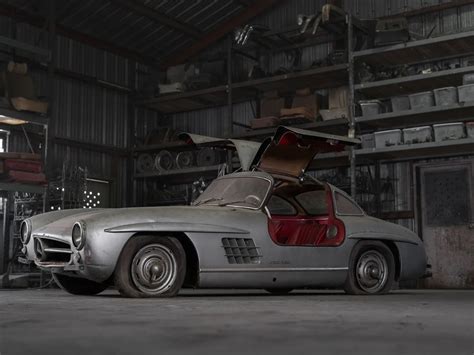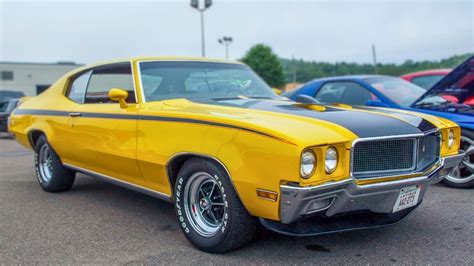
Jay Leno has unearthed a long-lost 1956 Mercedes-Benz 300 SL Alloy Gullwing, a discovery that reportedly surprised even Mercedes-Benz themselves due to its rarity and the mystery surrounding its disappearance for decades. The pristine condition of the vehicle, combined with its exceptionally rare alloy body, makes this find a significant event in automotive history.
Jay Leno, renowned car enthusiast and former host of “The Tonight Show,” revealed the meticulously preserved 300 SL Alloy Gullwing on his YouTube channel, “Jay Leno’s Garage,” captivating car collectors and enthusiasts worldwide. The discovery highlights the model’s extraordinary features, its limited production run, and the captivating story of its disappearance and subsequent rediscovery. According to Leno, “This car… is one of the great finds.” He further emphasized its significance, stating, “Mercedes was shocked too!” underscoring the unexpected nature and historical importance of this automotive gem surfacing after so many years.
The Mercedes-Benz 300 SL Alloy Gullwing is considered one of the most desirable and sought-after cars ever produced. What sets this particular model apart is its lightweight alloy body, a feature found in only 29 examples ever made. These alloy-bodied Gullwings were specifically designed for racing and offered significant performance advantages over their steel-bodied counterparts, thanks to the substantial weight reduction. This particular car, chassis number 198.040-5500629, has an intriguing history, which Leno pieced together with help from Mercedes-Benz Classic experts.
The car was originally delivered to New York in 1956 and was owned by just a handful of individuals, its whereabouts becoming increasingly obscured over the decades. The Alloy Gullwing’s lightweight construction, with aluminum panels replacing the standard steel, made it significantly faster and more agile. The alloy body reduced the car’s weight by approximately 200 pounds, contributing to improved acceleration, braking, and handling. This enhanced performance made it a formidable competitor on the racetrack.
Leno’s acquisition of the Alloy Gullwing involved a complex trail of research and authentication. “Finding this car was like uncovering a hidden treasure,” Leno remarked. The authentication process involved consulting with Mercedes-Benz Classic, who meticulously examined the car’s chassis number, engine number, and body features to verify its authenticity and original specifications. The experts confirmed that the car was indeed one of the original 29 alloy-bodied Gullwings, reinforcing its rarity and historical value.
The Alloy Gullwing features a 3.0-liter inline-six engine with mechanical fuel injection, producing approximately 240 horsepower. This engine, coupled with the lightweight body, allowed the car to achieve a top speed of around 160 mph, making it one of the fastest production cars of its time. The car’s distinctive gullwing doors, which open upwards, add to its iconic status and contribute to its unique appeal. The interior of the Alloy Gullwing is equally impressive, featuring meticulously crafted leather seats, a wood-rimmed steering wheel, and elegant instrumentation. The overall design reflects the high standards of craftsmanship and attention to detail that characterized Mercedes-Benz in the 1950s.
The restoration process was carried out with meticulous care to preserve the car’s originality and historical accuracy. Leno entrusted the restoration to a team of skilled technicians who specialized in vintage Mercedes-Benz vehicles. The restoration involved carefully removing the old paint, repairing any damaged panels, and applying a new coat of paint that matched the original factory color. The interior was also restored to its original condition, with new leather upholstery and refurbished trim.
The Alloy Gullwing’s rarity and historical significance have made it a highly sought-after collector’s item. In recent years, examples of the Alloy Gullwing have sold for several million dollars at auction, reflecting their value and desirability among collectors. The discovery of this particular car by Jay Leno is expected to further increase interest in the model and drive up its value even further.
The Mercedes-Benz 300 SL Alloy Gullwing represents a high point in automotive engineering and design. Its combination of lightweight construction, powerful engine, and iconic styling made it a true legend in the world of sports cars. The car’s success on the racetrack also helped to solidify Mercedes-Benz’s reputation as a leading manufacturer of high-performance vehicles. The Alloy Gullwing’s legacy continues to inspire automotive designers and engineers to this day.
The rediscovery of the 1956 Mercedes-Benz 300 SL Alloy Gullwing has generated considerable excitement among car enthusiasts and collectors worldwide. The car’s rarity, historical significance, and pristine condition make it a truly exceptional find. Jay Leno’s dedication to preserving automotive history and sharing his passion with others has made this discovery all the more special.
Jay Leno’s passion for automobiles is well-known, and his collection includes a diverse range of vehicles, from vintage classics to modern supercars. Leno’s YouTube channel, “Jay Leno’s Garage,” provides a platform for him to share his knowledge and enthusiasm with millions of viewers around the world. He routinely features detailed reviews, restoration projects, and interviews with automotive experts. His deep understanding of automotive history and engineering, coupled with his engaging personality, has made him a respected voice in the automotive community.
Leno’s work in preserving automotive history extends beyond his personal collection. He actively supports automotive museums and educational programs, and he often participates in vintage car rallies and events. His efforts to promote automotive education and preservation have earned him widespread recognition and respect within the automotive industry. He believes that preserving automotive history is essential for understanding the evolution of technology and design, and he is committed to ensuring that future generations have the opportunity to appreciate these historical artifacts.
The Mercedes-Benz 300 SL, in general, revolutionized the automotive industry upon its release. The “SL” designation stood for “Sport Leicht” (Sport Light), highlighting its focus on performance and lightweight construction. Introduced in 1954, the 300 SL was initially developed as a racing car before being adapted for road use. The road version retained many of the racing car’s features, including its tubular spaceframe chassis and direct fuel injection, making it a technologically advanced vehicle for its time.
The 300 SL’s iconic gullwing doors were a direct result of the tubular spaceframe chassis, which made it impossible to fit conventional doors. The gullwing doors quickly became one of the car’s most distinctive features, contributing to its unique and unforgettable design. The car’s performance was also impressive, with a top speed of around 160 mph, making it one of the fastest production cars of its era.
The 300 SL was an instant success, both on and off the racetrack. It won numerous races and rallies, cementing its reputation as a high-performance sports car. The car’s elegant styling and luxurious interior also made it popular among wealthy individuals and celebrities. The 300 SL became a symbol of status and sophistication, and it remains one of the most iconic and desirable cars ever produced.
The standard production 300 SL, while highly regarded, differs significantly from the Alloy version. The Alloy Gullwing represented the pinnacle of the 300 SL’s development, combining lightweight construction with enhanced performance. The alloy body was not the only difference between the two models. The Alloy Gullwing also featured a different engine with increased power output, as well as upgraded suspension and braking systems. These enhancements made the Alloy Gullwing even faster and more agile than the standard production model. The Alloy Gullwing was primarily intended for racing, and it was campaigned successfully in various events around the world. Its limited production run and racing pedigree have made it one of the most sought-after and valuable cars in the world.
The rediscovery of the Leno’s 1956 Mercedes-Benz 300 SL Alloy Gullwing not only highlights the value of preserving automotive history, but also emphasizes the thrill of unearthing a long-lost treasure. This specific model, given its history and features, will likely be a centerpiece in Leno’s collection and a source of fascination for car enthusiasts worldwide for years to come. The story serves as a reminder of the enduring appeal of classic cars and the importance of preserving them for future generations.
The meticulous restoration process further underscores the dedication required to maintain these historical artifacts. Restoring a car like the Alloy Gullwing is not simply a matter of replacing worn parts; it requires a deep understanding of the car’s original construction and design. The restorers must carefully research the car’s history, source original parts, and use traditional techniques to ensure that the restoration is as accurate as possible. This process can take years to complete and can cost a significant amount of money.
Jay Leno’s commitment to preserving automotive history is commendable, and his efforts have helped to raise awareness of the importance of preserving these historical artifacts. His rediscovery of the 1956 Mercedes-Benz 300 SL Alloy Gullwing is a testament to his passion and dedication, and it will undoubtedly inspire others to join in the effort to preserve automotive history.
The fact that Mercedes-Benz was reportedly “shocked” by the rediscovery further illustrates the obscurity surrounding this particular vehicle. It suggests that even the manufacturer itself had lost track of the car’s whereabouts, highlighting the challenges involved in tracking down rare and historically significant vehicles. This also points to the effectiveness of Leno’s team and their meticulous research.
The car’s journey from its initial delivery in New York in 1956 to its rediscovery decades later remains shrouded in mystery, with only a few owners documented. Piecing together the car’s history required extensive research and collaboration with Mercedes-Benz Classic experts, underscoring the importance of preserving historical records and documentation. The Alloy Gullwing serves as a tangible link to the past, providing valuable insights into the automotive industry of the 1950s and the evolution of technology and design.
The car’s discovery also serves as a reminder of the importance of authentication and verification. Before acquiring the Alloy Gullwing, Leno and his team conducted thorough research to confirm its authenticity and original specifications. This involved examining the car’s chassis number, engine number, and body features, as well as consulting with Mercedes-Benz Classic experts. This rigorous authentication process is essential for ensuring that collectors are acquiring genuine historical artifacts and protecting themselves from fraud.
Leno’s passion for cars began at a young age, and he has spent his entire life collecting, restoring, and driving them. His collection includes a wide variety of vehicles, from vintage classics to modern supercars, and he is known for his encyclopedic knowledge of automotive history and engineering. Leno’s YouTube channel, “Jay Leno’s Garage,” provides a platform for him to share his passion with millions of viewers around the world, and he has become a respected voice in the automotive community.
Leno’s collection is not just a hobby; it’s a reflection of his deep appreciation for automotive history and engineering. He believes that cars are more than just machines; they are works of art that reflect the ingenuity and creativity of their designers and engineers. He sees each car as a unique piece of history, and he is committed to preserving them for future generations to enjoy. His dedication to preserving automotive history extends beyond his personal collection. He actively supports automotive museums and educational programs, and he often participates in vintage car rallies and events. His efforts to promote automotive education and preservation have earned him widespread recognition and respect within the automotive industry.
The 1956 Mercedes-Benz 300 SL Alloy Gullwing’s rediscovery underscores the importance of preserving automotive history and celebrating the ingenuity and craftsmanship of the past. It is a testament to the enduring appeal of classic cars and the passion of collectors like Jay Leno who are dedicated to preserving them for future generations. The car’s rediscovery is a reminder that there are still hidden treasures waiting to be discovered, and that the pursuit of automotive history can be a rewarding and enriching experience.
The impact of this discovery extends beyond the automotive world, highlighting the significance of preserving historical artifacts in all fields. Whether it’s a rare car, a historical document, or a work of art, these artifacts provide valuable insights into the past and help us to understand the present. Preserving these artifacts requires dedication, expertise, and a commitment to historical accuracy, and it is essential for ensuring that future generations have the opportunity to learn from the past.
The rediscovery of the Alloy Gullwing is a reminder that even after decades of obscurity, these treasures can still be found, reminding us of the importance of continued exploration and preservation efforts. It reinforces the notion that automotive history is a living, breathing entity, constantly evolving as new discoveries are made and new stories are told. Leno’s find adds another chapter to this ongoing narrative, ensuring that the legacy of the 1956 Mercedes-Benz 300 SL Alloy Gullwing will continue to inspire and captivate car enthusiasts for years to come. This particular example of the Alloy Gullwing, now under Leno’s stewardship, will undoubtedly become a significant artifact, carefully preserved and shared with the world, further solidifying its place in automotive history.
The meticulous documentation of the car’s history, from its original delivery to its eventual rediscovery, underscores the importance of record-keeping in the preservation of historical artifacts. Without accurate records, it would be impossible to authenticate the car and trace its provenance, making it difficult to assess its value and significance. The availability of detailed historical records is essential for ensuring that these artifacts are properly preserved and understood for future generations.
The rarity of the Alloy Gullwing also underscores the importance of responsible stewardship. As one of only 29 examples ever made, this car is a unique and irreplaceable piece of history. Its preservation requires careful attention to detail, as well as a commitment to maintaining its original condition. Leno’s dedication to preserving the car’s originality is a testament to his respect for automotive history and his commitment to ensuring that this treasure is enjoyed by future generations.
Frequently Asked Questions (FAQ)
1. What makes the 1956 Mercedes-Benz 300 SL Alloy Gullwing so rare and valuable?
The 1956 Mercedes-Benz 300 SL Alloy Gullwing is exceptionally rare because only 29 examples were ever produced with an alloy body. This lightweight construction, using aluminum panels instead of steel, reduced the car’s weight by approximately 200 pounds, significantly enhancing its performance in terms of acceleration, braking, and handling. According to Jay Leno, “This car… is one of the great finds.” Its racing pedigree, combined with its limited production and iconic gullwing doors, makes it highly sought after by collectors.
2. How did Jay Leno discover this particular Alloy Gullwing, and what was the authentication process?
The discovery involved a complex trail of research and investigation. Leno did not explicitly detail the finding of the car to protect his source, but he acquired it through his network of collectors and enthusiasts. The authentication process was meticulous, involving consultation with Mercedes-Benz Classic experts. These experts examined the car’s chassis number (198.040-5500629), engine number, and body features to verify its authenticity and original specifications. This confirmed that the car was indeed one of the original 29 alloy-bodied Gullwings.
3. What are the key differences between the Alloy Gullwing and the standard steel-bodied 300 SL Gullwing?
The most significant difference is the body material. The Alloy Gullwing features aluminum body panels, which reduce the car’s weight and improve its performance. Additionally, the Alloy Gullwing often had a modified engine with increased power, as well as upgraded suspension and braking systems. These modifications made it even faster and more agile than the standard steel-bodied version.
4. What is the current estimated value of a 1956 Mercedes-Benz 300 SL Alloy Gullwing, and how might this discovery impact its value?
In recent years, examples of the Alloy Gullwing have sold for several million dollars at auction. Given its pristine condition and the high-profile discovery by Jay Leno, this particular car is likely to be worth even more. The rediscovery is expected to generate further interest in the model and drive up its value among collectors.
5. What steps were taken during the restoration process to ensure the Alloy Gullwing’s originality was preserved?
The restoration was carried out with meticulous care by skilled technicians specializing in vintage Mercedes-Benz vehicles. The process involved carefully removing the old paint, repairing any damaged panels, and applying a new coat of paint that matched the original factory color. The interior was also restored to its original condition, with new leather upholstery and refurbished trim. The emphasis was on preserving the car’s original features and specifications.









